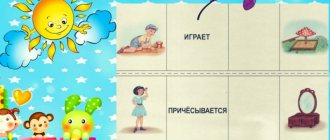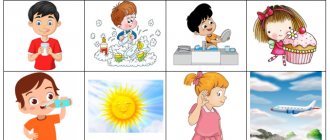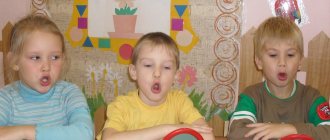Speech therapy lesson summary Topic: “Proposal. Word".
Speech therapy lesson summary Topic. Offer. Word.
Objectives: to consolidate the concepts: “oral and written speech”, “word”, “sentence”, “text”. Develop skills in language analysis and synthesis: dividing text into sentences, sentences into words and composing sentences from words; develop the articulatory apparatus, thinking, coordination of speech with movement, graphomotor skills; to form the duration, smoothness, and strength of voluntary speech breathing. To clarify children’s ideas about the structure of the human body and the purpose of individual parts of the body, to consolidate orientation in space. Develop the ability to listen to yourself and others; instill personal responsibility for doing work. Equipment: baby dragon toy, envelope with written tasks for children, computer, subject and subject pictures.
PROGRESS OF THE LESSON I. Organizational moment Repeat: SA-sa-sa-here comes the wasp. So-so-so - Sonya has a wheel. Os-os-os - Sanya has a dog. Su-su-su - we saw the forest in the forest. II. Articulation gymnastics and breathing exercises. - Guys, today we will do gymnastics for our tongue so that it pronounces sounds correctly. Place mirrors on your desk in front of you. 1. Delicious jam. 2. Needle. 3. Spatula. 4. Punish the naughty tongue. 5. Calyx. Breathing exercise - “Sultans”.
III. Working on the topic. - Guys, the Dragon sent us a letter! And in the envelope there is a letter with assignments. - Tell me, what is speech needed for? (To communicate, talk.) - What kind of speech is there? (Oral and written.) - How do we use oral language? (We hear and pronounce oral speech.) - What kind of written or oral speech is the letter that the Dragon wrote? (In written speech.) - Yes, if not for written speech, would the Dragon be able to communicate with us? (No, I couldn’t.) - To find out what is written or printed, you need to learn to read. Look at the pictures. Who in the pictures uses spoken language and who uses written language?
? Make a word from letters. M, I, R K, o, t - If you rearrange the letters, what new word will you get?
Making sentences based on the picture:
— Guys, look at the pictures and make sentences for them. Leaves fall. It rains often. Birds fly south. People sunbathe on the beach. The children went to school. - Tell me, which of the sentences you have compiled is superfluous? (People sunbathe on the beach.)
- Why? (All other sentences are about autumn, and “People sunbathing on the beach” are about summer.) Drawing up graphic diagrams of sentences.
— Guys, what sentences have you made just now? (Text.) - Why do you think so? (The sentences are united by a common theme - “Autumn.”) Give the text a title. (Autumn.) - What does the text consist of? (The text consists of sentences.) - What does a sentence consist of? (The sentence consists of words.) - The first word in the sentence is written with what letter? (Capital letter.) - How is one sentence separated from another in oral speech? (Pause - stop.) - How is one sentence separated from another in written speech? (A period, a question mark or an exclamation mark.) - Are the words in the sentence written together or separately? (Apart.)
- Let's remember how you can write a sentence without knowing the letters. Each sentence can be written down and designated using a diagram. This makes it easier to determine how many words are in a sentence and how many sentences we have said. The beginning of a sentence is shown by a line protruding above the strip to the left, and the end of the sentence is shown by a dot to the right of the strip.
- Guys, the Dragon has prepared another task for you! Make graphic diagrams of these sentences. - Let's check who correctly compiled the graphical diagrams of the sentences.
VI. Physical exercise Drakosha. (presentation)
VII. Determining the boundaries of sentences in the text. - Guys, let's do one more task! Read the text. Determine how many sentences it contains. Mark the beginning and end of each sentence.
In autumn there is silence in the forest, only leaves rustle under your feet, suddenly a pine branch cracks, the squirrels are starting a game.
VI I. Identification of body parts in Buratina. - Today we will find out what parts of the body a person has, why a person needs them. Knowing the structure of your body means knowing yourself.
— Guys, what part of a person’s body is the most “smart”? (Head). Everyone should have a very smart head.
— What other parts of the human body can you name and show?
There are nails on our fingers, On our hands there are wrists and elbows. Crown, shoulders, forehead and chest And don’t forget the shoulder blades. Hips, heels, two feet, lower leg and ankle. There are knees and a back, but there is only one. On our head we have two ears and two lobes. Eyebrows, cheekbones, and temples, And eyes that are so close. Cheeks, nose and two nostrils, Lips, teeth - look! Chin under lip. This is such a person.
- Call it in one word: head, back, nose, mouth - what is that? (Body parts). - The body has arms and legs.
- Guys, tell me the parts of the hand /shoulder, elbow, palm, fingers, nails/.
-What parts of the leg do you know? /thigh, knee, lower leg, foot, fingers, nails, sole, heels/.
- Oh, what animals don’t have is a face.
- Do you know what other body parts domestic animals do not have, but humans do? /palm, fingers, nails, elbows, arms/.
- Show your right hand, stamp your left foot, turn your head to the right.
? Formation of plural nouns. Ball game: "One - many."
- And now we’ll play the game “One is Many”, I name one object, and you name many. Ear - ears, neck -, eye -, hair -, head -, forehead -, mouth -, nose -, cheek -, finger -, elbow -, eyebrow -….
? Agreement of a noun with a numeral. Game "Think and answer". Let's help Drakosha and Pinocchio - How many eyes do two children have? /two children have four eyes/ - How many ears do three boys have? /those boys have six ears/ - How many fingers are on your left hand? / there are five fingers on the left hand / - How many noses do three girls have? /three girls have three noses/
? Formation of nouns using diminutive suffixes and using the suffix “ISCH”.
not a nose - but ... /nosish/, but the other has /nose/. not a mouth - but ... /mouth/, and the other has /mouth/. arms, legs, forehead, eyes, hair)
? Use of antonyms. Game: “Say the opposite” sad face - /cheerful/ dark hair - /blond/ long hair - /short/ straight hair - /curly/ big nose - /small/ fat -/thin/ tall- /short/ ? Polysemy of words. — Guys, there are words that sound the same, but have different meanings. The nose is on an airplane, on a ship, on a teapot; Handle - by the door, by the bag, fountain pen; The peephole is in the door, near the potatoes; The neck is at the bottle, at the child; The back is at the chair; Brushes – paint brush, grape brush; Tongue - near the shoe, cake; Legs - near the chair, near the mushroom.
VIII. Development of non-speech processes.
Draw the other half of the person in cells. XI. Lesson summary
DOWNLOAD PRESENTATION
Developed by a teacher-speech therapistVasilyeva Elvira Gennadievna
Cheboksary special (correctional) primary school-kindergarten No. 3 “Nadezhda” of the Chuvash Republic
slide 1
Goal: developing ideas about the content side of sentences to ensure its semantic completeness and communicative expediency
Tasks:
Educational:
1) developing the ability to determine the number and sequence of words in a sentence;
2) consolidation of the skill of grammatical formatting of sentences, coordination of words in a sentence;
3) differentiation of prepositions and prefixes,
Corrective:
4) development of logical thinking, memory, attention;
5) correction of fine and gross motor skills
Educational:
- developing a sense of responsibility and self-confidence;
- formation of personal qualities;
- cultivating a sense of respect for adults, the ability to communicate with teachers and children in a team
Equipment: screen, projector, computer, task cards, notebooks
Progress of the lesson
- Organizing time.
1. Development of visual perception and visual gnosis.
Speech therapist: Guys, what objects are shown on the slide? (frog, reeds, dragonfly - overlaid images) What are words made of? (from syllables)
How many syllables are in each of these words? (3)
slide 2
- Making proposals based on guessed pictures.
Speech therapist: What is a sentence? (words related to each other in meaning)
Make up a sentence with words - names of pictures. (The frog sat in the reeds and looked at the dragonfly.)
Speech therapist: How many words are there in your sentence?
- Formulating the topic of the lesson.
Speech therapist: Who guessed what we will do in class? (work with suggestions)
- Main part
1. Meet the hero.
Speech therapist: We received a mysterious letter. Review the recording. Try to decipher this letter and read it, then you will find out who wrote it. (There is a note on the cards, words in brackets are replaced with pictures)
Text of the letter: I have a (barrel) of honey. There is also a (jar) of jam. I will soon (come) to visit you and bring you a treat. (Winnie the Pooh)
slide 3
- Restoring deformed sentences.
Speech therapist: Winnie the Pooh loves honey very much, but the bees don’t let him get enough of it. Let's help Winnie the Pooh.
slide 4
Speech therapist: Make up sentences from the words the bees brought. Write down the resulting sentences.
Words: - it was summer, sultry (It was sultry summer.)
- jackdaw, on, fence, sat down (A jackdaw sat down on the fence.)
- Kolya, I asked a riddle (Kolya asked a riddle.)
- cat, attic, on, climbed (The cat climbed into the attic.)
- in, flooded, yard, skating rink, big, flooded (In the yard, the children flooded a large skating rink.)
Physical exercise for the eyes ( Masko ophthalmic simulator)
slide 5
- Establishing logical connections between words within sentences.
Speech therapist: Do you know Winnie the Pooh’s friends? (Piglet, Tigger, Eeyore, etc.)
slide 6
Tigger got naughty and rearranged the words in the sentences. Let's together correct logical errors and write the sentences correctly.
slide 7
— In the spring, the meadows flooded the river.
— The goat gave the girl water to drink.
— After summer, the long-awaited spring came.
Speech therapist: Tigger is pleased with your help. He will definitely tell Piglet about this.
slide 8
But suddenly impudent and hungry crows flew at Piglet.
Speech therapist: How to drive them away? (put up a scarecrow, shoot with a slingshot). Yes. But there is another method - birds do not like to exercise. Let's all start doing exercises together with Piglet, Tigger and Winnie the Pooh - the crows will immediately fly away.
slide 9
Physical exercise (with movements)
- Differentiation of prepositions and prefixes in sentences. Strengthening the skill of agreeing words in a sentence.
Speech therapist: The friends were having so much fun that they didn’t notice Eeyore. He is upset: the crows took some words with them. Eeyore just can't cope.
Speech therapist: Let's help the donkey Eeyore: complete the sentences by inserting words that suit their meaning. Think about how to correctly write small words in brackets - together or separately? What is the difference between a preposition and a prefix? (you can insert another word between the preposition and the word). Let's underline the spelling.
slide 10
________ (boy) ran (along) the garden path
_________ (from) swam (from) the shore. (Boat)
Zhenya _________ (on) wrote (on) the address on the envelope. (Petrov)
5. Training in determining the boundaries of sentences.
Speech therapist: While we were choosing words, a wise owl appeared in the clearing. She brought a letter from Christopher Robin .
slide 11
Speech therapist: The owl wrote down everything that the boy wanted to convey to his friends. See why it is difficult to read a letter? What did the owl forget? (put punctuation marks). When should you put a period at the end of a sentence? (when the thought is over)
Speech therapist: Let's correct the mistakes made by the owl. Read and write the text correctly.
Text of the letter:
A fresh breeze blew, the sun rose, the birds sang loudly, who is it that is pouring in the raspberry bushes, how the dew drops glisten, how beautiful the forest is at dawn.
slide 12
Speech therapist: What sentences are found in the text regarding the purpose of the statement? What punctuation did you use? (?, !, .)
Speech therapist: Read the fifth sentence with Eeyore, the first sentence with Winnie the Pooh, and the last sentence from Christopher Robin’s letter with Tigger.
- Summarizing. slide 13
Speech therapist: What is a sentence? Text?
What was difficult in the lesson and what was easy?
Slide captions:
Presentation for a speech therapy lesson on the topic: “Word, phrase, sentence” Speech therapist teacher of the State Budgetary Institution Central Pedagogical Medical Center of the Kalininsky District of St. Petersburg Elizaveta Yuryevna Grigorieva 2016
The word is the central unit of language Word - Word - Word - subject noun attribute adjective action verb
Word-object – noun What? Who? Masculine gender Neuter gender
Remember the words-objects - nouns, determine the gender of what the students are sitting at in class? what do they sleep on? what they sit and relax in? what do they sit on at the table? what do they have lunch for? Name all these furniture items in one word
Remember the nouns, determine the gender, name them in one word, the one who plays a musical instrument? the one who cooks the food? the one who builds houses? the one who heals people? the one who teaches children? professions
Attribute word - adjective color shape taste size
What elephant? What tree? ...
Which? Which? Which? Which? air - airy, airy, airy, airy world faith mind will kindness tenderness beauty peaceful-peaceful-peaceful-peaceful faithful-faithful-faithful-faithful smart-smart-smart-smart free-free-free-free kind-kind-kind- kind gentle-gentle-gentle-gentle beautiful-beautiful-beautiful
Action word – verb What to do? What to do? run - run - runs - run scream look catch cart demand letter scream-screams-scream look-looks-look catch-catches-catch carry-carries-carry ask-ask-ask write-write-write
Collocations are two or more words related to each other in meaning and grammatically; cold wind, interesting book, tall tree, white clouds, one word depends on another, the question is asked from the main word to the dependent; the wind (what?) is cold, the book (what?) is interesting, the tree (what?) is tall, the clouds (what?) are white
Form phrases bake throw sell collect buy build
The subject and predicate (grammatical basis) do not form a phrase. The guys sang a funny song. There are two phrases in this sentence: 1) they sang (what?) a song 2) a (what?) funny song. The friendly guys sang a funny song. There are three phrases in this sentence: 1) the guys (what?) were friendly 2) sang (what?) a song 3) a (what?) funny song
A word with a preposition, homogeneous members of the sentence do not form a phrase by the window by the large window on the shelf on the bookshelf green, red, blue green, red, blue maple, birch, oak maple, birch, oak leaves Which one? Which? Which? Which?
Types of phrases Nominal Main word - noun, adjective, numeral, pronoun silk scarf, ready to help, two pencils, something new; Verbal The main word is the verb to wander through the forest, sit on a chair, give flowers; for example for example
Suggestion guys, today, everyone is handing over waste paper; today they hand over, hand over waste paper; Today all the guys hand over waste paper. words phrase sentence
Sentence - expresses a complete thought A sentence can be: narrative The house stood by the sea. interrogative Why did you leave class? exclamation How nice it is in the autumn forest!
Make a sentence game in Where the collection How good help
Divide the text into sentences In the morning, Vasilek and his grandfather went fishing, the road went through the forest, the fishermen noticed a secluded place on the bank of a quiet river, they threw their fishing rods into the water, the grandfather caught a big pike, Vasilek did not bite for a long time, suddenly the float went under the water, the boy pulled the fishing rod, the first fish was caught. Vasilek the grandfather beamed with pride and praised his grandson
Correct the misspelled sentences The dog was walking his grandfather in the park. Grandfather was walking the dog in the park. The chicks fed the waxwings. The waxwings fed the chicks. Examples solved difficult students. Students solved difficult examples.
YOUNG GUYS! THANK YOU EVERYONE FOR THE LESSON!


